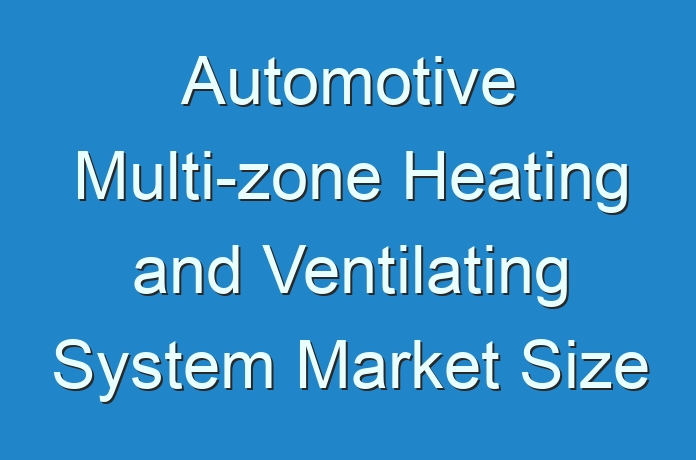
Automotive Multi-zone Heating and Ventilating System Market: Introduction
- Heat Ventilation and Air Conditioning (HVAC) unit is a system that heats or cools air drawn from outside or inside of the vehicle and distributes it to passengers as well as the driver at the desired temperature. This system creates ambient comfort within the vehicle.
- Multi-zone HVAC systems are used to separate different climate control areas inside the vehicle cabin. Multi-zone air conditioning systems have separate controls for the driver and passengers. These systems offer different temperatures and fan speeds. Air condition vents are located at multiple locations across the vehicle cabin because of the different zones.
- There are no walls or dividers between different zones; therefore, the air conditioning unit achieves the desired temperature by mixing air flow in order to create an outcome that is the average of its output
Are you a start-up willing to make it big in the business? Grab an exclusive PDF Brochure of this report https://www.transparencymarketresearch.com/sample/sample.php?flag=B&rep_id=81427

Key Drivers of Automotive Multi-zone Heating and Ventilating System Market
- Better driving comfort is a major factor affecting the design and modelling of vehicles. Traditional automotive HVAC systems treat the entire vehicle interior as one large compartment. The air vents were designed with the focus on driver comfort. This often resulted in poor air circulation in the rear of the vehicle. These drawbacks of traditional HVAC systems prompted vehicle occupants to demand more individualized comfort. This led to the emergence of multi-zone HVAC systems. These systems create separate climate zones in the vehicle as per comfort of every occupant. Thus, changing customer expectations for vehicle comfort are driving the automotive multi-zone heating and ventilating system market across the globe.
- Rise in per capita GDP has led to an increase in the purchasing power of people across the world. According to the European Union, spending of global middle class population is expected to reach US$ 64 Trn by 2030 from US$ 37 Trn in 2017. This rise in purchasing power has increased the sale of luxury vehicles and utility vehicles. These vehicles are fitted with advanced multi-zone HVAC systems that provide climate control for three, four, or even five separate zones. The BMW X7, Mercedes-Benz GLS, and other such luxury vehicles have five zone climate control systems. Thus, increase in demand for luxury and utility vehicles is boosting the global automotive multi-zone heating and ventilating system market.
Challenges in Global Automotive Multi-zone Heating and Ventilating System Market
- High maintenance cost and complexity of the systems due to use of additional air vent doors and actuators to separate airflow are hampering the global automotive multi-zone heating and ventilating system market
Impact of COVID-19 Pandemic on Automotive Multi-zone Heating and Ventilating System Market
- Production and sale of vehicles has declined due to the COVID-19 pandemic. This has adversely affected the demand for multi-zone air conditioning systems. However, governments of various countries are easing restrictions related to the pandemic. Companies are restarting their operations with precautionary measures. This is estimated to propel the global automotive multi-zone heating and ventilating system market.
Opportunity in Automotive Multi-zone Heating and Ventilating System Market
- Consumer inclination toward next-generation mobility, such as electric and autonomous vehicles, is prompting Tier 1 suppliers of HVAC systems and OEMs to develop smart HVAC systems that sense the presence of an occupant and automatically adjust the air flow and temperature. These systems reduce fuel or power consumption and provide individualized comfort. These advanced smart HVAC systems are estimated to offer significant opportunities for the players in the global automotive multi-zone heating and ventilating system market in the near future.
For Right Perspective & Competitive Insights on Automotive Multi-zone Heating and Ventilating System Market, Request for a Sample
North America & Europe Hold Significant Share of Global Automotive Multi-zone Heating and Ventilating System Market
- North America and Europe account for significant share of the global automotive multi-zone heating and ventilating system market due to the strong presence of luxury car manufacturers in these regions who are incorporating these zonal HVAC systems in their vehicles. OEMs such as Daimler AG, BMW AG, and AB Volvo are some of the manufacturers of luxury cars in North America and Europe who have equipped their luxury and long vehicles including SUVs with multi-zone HVAC systems.
Key Players Operating in Automotive Multi-zone Heating and Ventilating System Market
The global automotive multi-zone heating and ventilating system market is highly concentrated due to the presence of the leading manufacturers. Key players operating in the global automotive multi-zone heating and ventilating system market include:
- Air International Thermal Systems
- Behr-Hella Thermocontrol GmbH
- BorgWarner Inc. (Delphi Technologies)
- DENSO CORPORATION
- ESTRA
- Hanon Systems
- MAHLE GmbH
- Sanden Holdings Corporation
- VALEO
- Vishay Intertechnology, Inc.
Global Automotive Multi-zone Heating and Ventilating System Market: Research Scope
Global Automotive Multi-zone Heating and Ventilating System Market, by Operation
- Automatic
- Manual
Global Automotive Multi-zone Heating and Ventilating System Market, by Number of Zones
- Two Zones
- Three Zones
- Four Zones
- Others
Global Automotive Multi-zone Heating and Ventilating System Market, by Vehicle Type
- Passenger Vehicle
- Luxury/Premium Vehicles
- Mid-segment Vehicles
- Entry-class Vehicles
- Commercial Vehicle
- Light Commercial Vehicles
- Heavy Commercial Vehicles





